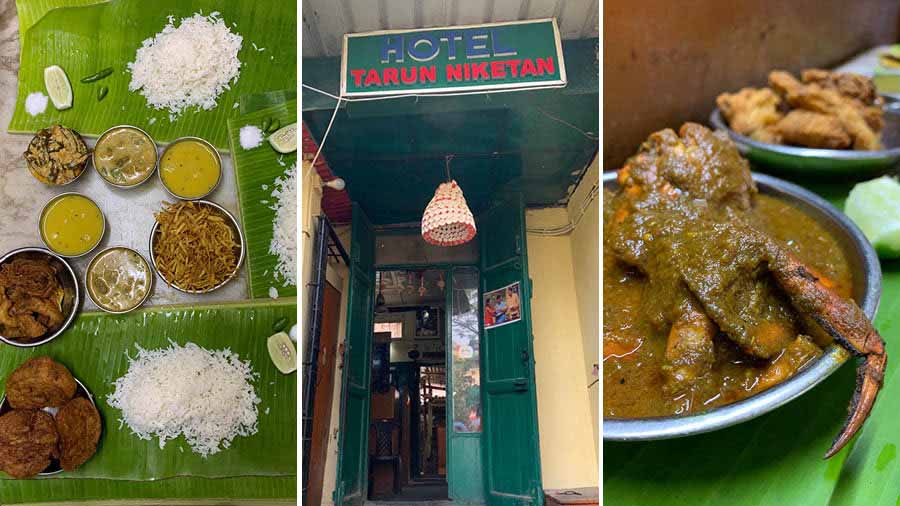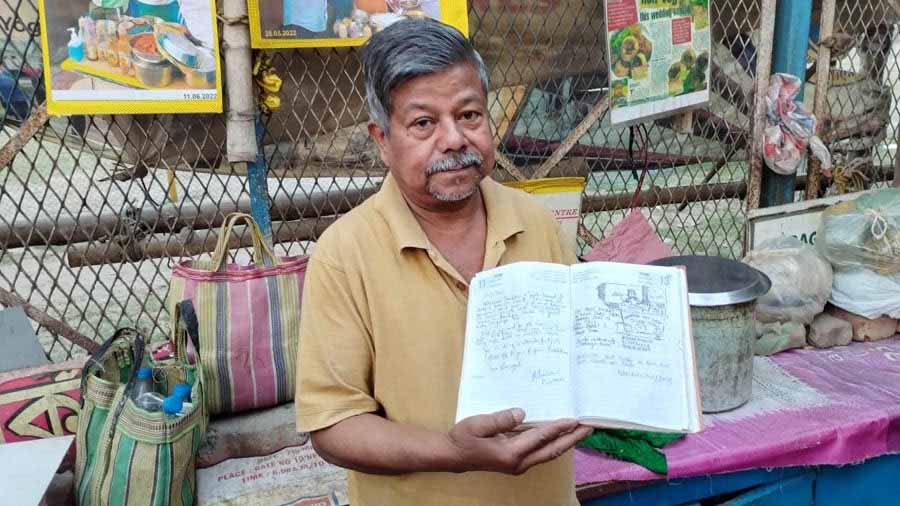After our Thammas and Didus, if there’s any institution that represents the city and the region’s cuisine in the most delicious and respectful way — it has got to be the pice or bhaat’r hotel. There’s probably one in every bylane of Bengal’s cities and towns. Over the years many of these eateries came about as an affordable and accessible way for working professionals, bachelors, students and travellers to eat bari’r style ranna. And while some have even gone on to become century-old establishments, they mostly remain magically untouched with time, and more importantly, fads.
One of the highlights of eating at the better Pice hotels is that the menu changes daily based on what’s fresh and seasonal in the bazaar and of course on the mood and the whims of the matriarch or maharaj responsible for the kitchen. They always run out of the best stuff early and never carry forward any prep to the next day. But most importantly, these humble eateries still promote what I think is one of the greatest customs of the region — that even everyday meals, especially lunch, are still prepared, served and eaten as a course by course degustation.
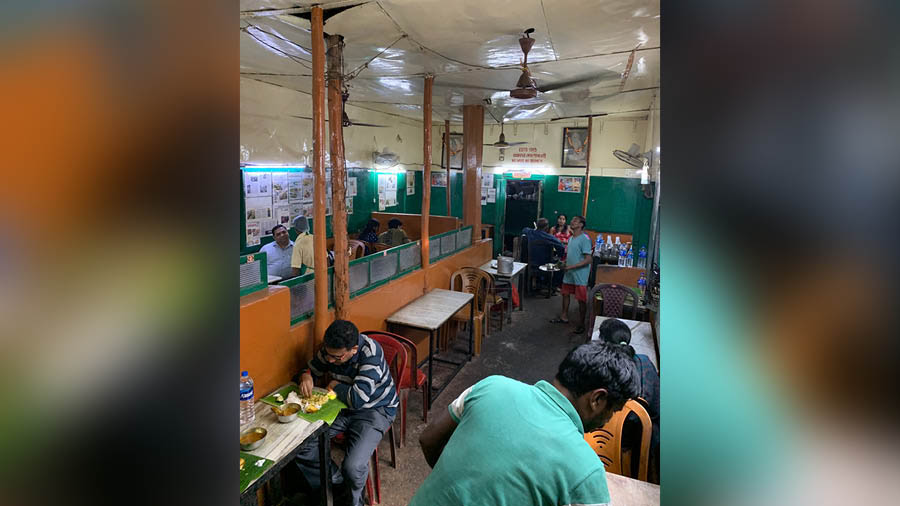
The interior of the eatery
And the mark of the best bhaat’r hotels is that they don’t offer a set thali of any kind — instead the servers lovingly and enthusiastically suggest the next course to you as you’re just about to finish the one on your kolapata. After a little teto, there are dal and bhaaja, a bati of chorchori, a chhoto maachh or two in jhol, some mangsho and chutney. By the end of the meal, there’s a good chance that you’ve eaten your way through almost the entire morning bazaar. And a few weeks back, I did just that at one of my favourites — Tarun Niketan in the Lake Market area — and the focus of this article.
Shukto shows the day
The eatery has been in the same location on Rashbehari for over a hundred years. The reason I end up visiting it so often is because it’s a five-minute auto ride from the Sienna kitchen and it also has one of the lightest-homeliest cooking hands, akin to almost bari’r ranna, with only their heavier maachh and mangsho preps getting a touch of peyaz and roshun. And this really helps because it means you can enjoy yourself and indulge in that many more courses.
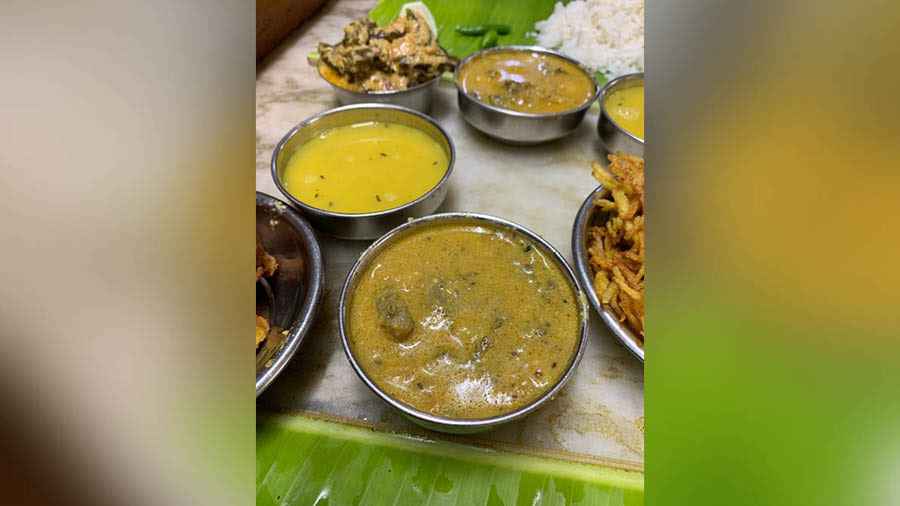
‘I almost always begin at Tarun Niketan with shukto as theirs has the flavours and textures of a biyebari version, but without any of the heaviness’
And keeping in mind the indulgence ahead, here are some tips or SOPs for this particular hotel that I keep in mind and will help with your visit. To begin with, don’t go alone but never visit with a group that’s larger than four people — they don’t have large tables and only a single four-seater. My advice, go with one or two big eaters; that way, you don’t have to wait to be seated or have your group split up.
I’d also recommend getting there early; that way, all the day’s bhaajas are fresh and nothing on the menu is 86ed (I’m saddest on the days they run out of the chitol peti and kochi patha jhol). Most importantly, go there on a weekday, as that’s the time of week they seem to be busier and hence, prepare a far more diverse menu. And last but not the least, and especially if you’re a Bengali diner, set your expectations right and forgive them if they’re having an off day. As a kitchen, when you’re cooking a different menu daily with varying levels of technique or skill, you occasionally get a sub-par dish, sometimes even a meal. But this even happens to our Didus and Thammas kitchens on occasion and quite often, there’s no reasonable reason behind this. Treat this meal as a vintage of wine, because when all the right factors come together magically, a meal at Tarun Niketan is simply undeniable.

It is recommended getting there early; that way, all the day’s bhaajas are fresh and nothing on the menu is 86ed
And thank the Food Gods; my last meal there was just that. My fellow diners were a young chef and his younger brother visiting Kolkata with the sole purpose of eating and drinking their way through the entire city. With that greedy intention in mind and their growing-from-boys-to-men appetites, we ate one of the grander progressions a Bengali kitchen could hope to muster. I almost always begin at Tarun Niketan with shukto as theirs has the flavours and textures of a biyebari version, but without any of the heaviness. It also helped that it was prepared in peak winter, so the medley of bitter, root and green veggies were in perfect harmony. Smaller tip here as well — the day the shukto is good at Tarun Niketan, chances are so are the rest of the preps, so go ahead and order away with elan.
Bhaajas with the punch and the pinch
For dal and bhaaja, we decided to go with a patla moshuri’r dal with a hint of paanch phoron — so the focus could be on the bhaaja that we could smell being freshly fried. The bhaaja department is one that Tarun Niketan really excels at because they always look beyond just the jhuri-aloo, begun and potol. That day we went for bok-phool bhaaja as well as the laborious-to-make pur-diye chaal-kumro bora. I have had other vegetable variations of the latter — think kakrol, laal kumro or begun — but this one is my favourite as the chaal kumro has a subtle sweetness that doesn’t get in the way of the punchy shorshe-narkol stuffing.
We moved on to three kinds of torkari — two of which were maachh based. The dhnarosh or bhindi diye poshto is one of those brilliant ways of enjoying the creamy-bhaat-ghoom-inducing-dreamy properties of poppy seed without the starchy heaviness of aloo.
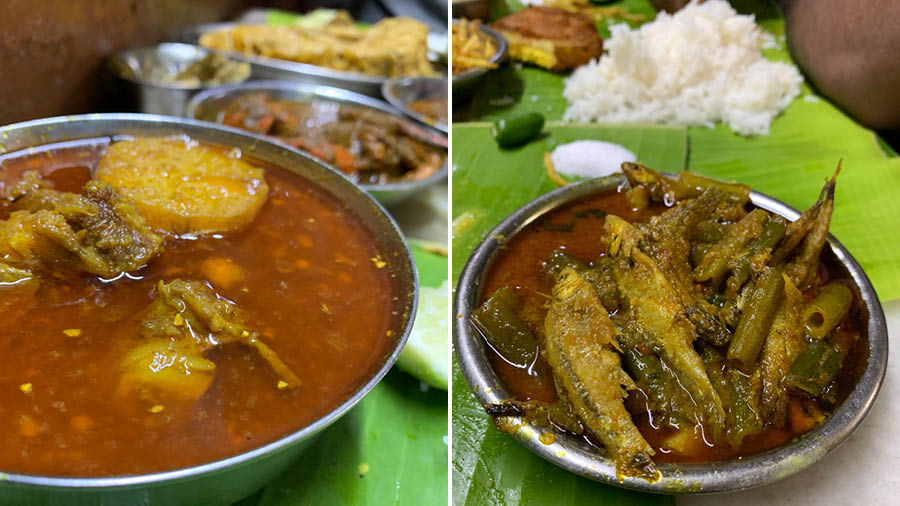
Kochi patha’r jhol and maurola maachh
I always thought that tangra was the perfect maachh for a halka peyazkoli jhol, but Tarun Niketan’s maurola maachh version has me rethinking that. If anything, the maurola maachh has a delicate earthy sweetness that pairs even better with the fresher, greener flavours of the peyazkoli. But my favourite had to be the kucho chingri diye thor’r chorchori. The thor had been cooked to a perfect al-dente crunch, yet was juicy with the sweetness of the tiny freshwater prawns. And clearly the maharaj in the kitchen knows a thing or two about making bhaaja/gorom moshla because this prep had just the perfectly fragrant pinch added to it right at the end.
The rosho-gold-a standard
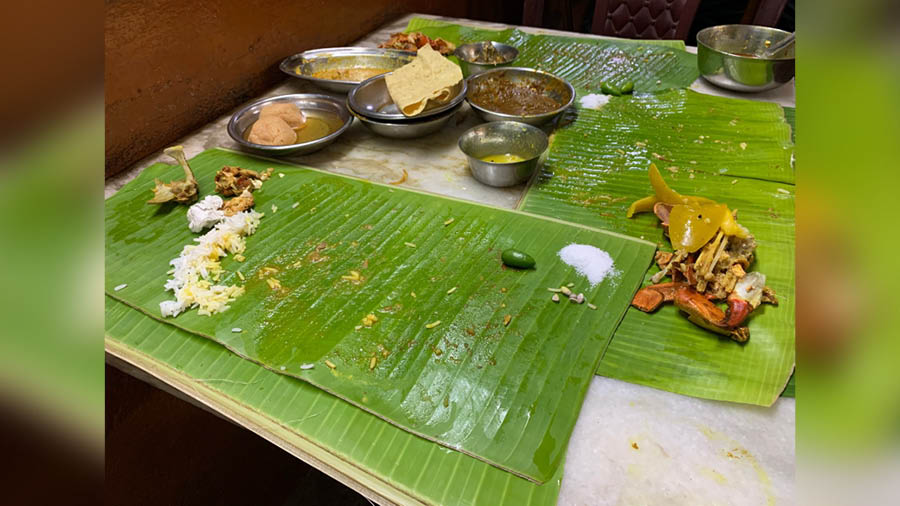
Empty kolapatas — what you can expect to see after a meal at Tarun Niketan
By the time it came to our last go-around the kolapata, I was already sinking, but our doting server and my fellow diners buoyed me on towards a final push. And boy did we go all out with kaakra’r jhaal, The chitol maachh’r peti and the kochi patha jhol — the last being a signature at this pice hotel. And that’s telling thing about the cooking hand behind the Tarun Niketan ranna and recipes. At most other bhaat’r hotels, due to the heavy nature of those preps, it’s very hard to end the meal on any one of those dishes, let alone all three of them. And yet we polished all three off effortlessly. I particularly liked the use of a small to medium-size kaakra. While they’re a little harder to break down, they are sweeter and make for a tastier jhol. The chitol maachh was meatier and more melt in my mouth then some of the best pork belly preps I’ve had. And the kochi patha, as always, had this soulful quality about the jhol — akin to a great ramen broth — great to have with or without any form of carbs or starch.
I think the only anomaly in the meal was the aam’r tok that followed, which while well-prepared, felt a little out of place due to it being a winter month. But it was more than made up for with our final bite — disappear on your palate, freshly made gur’r roshgolla, still warm from the chashni they’d just been bathed in. I always say that north Kolkata is the better para for mishti, but these gems more than matched that gold standard.
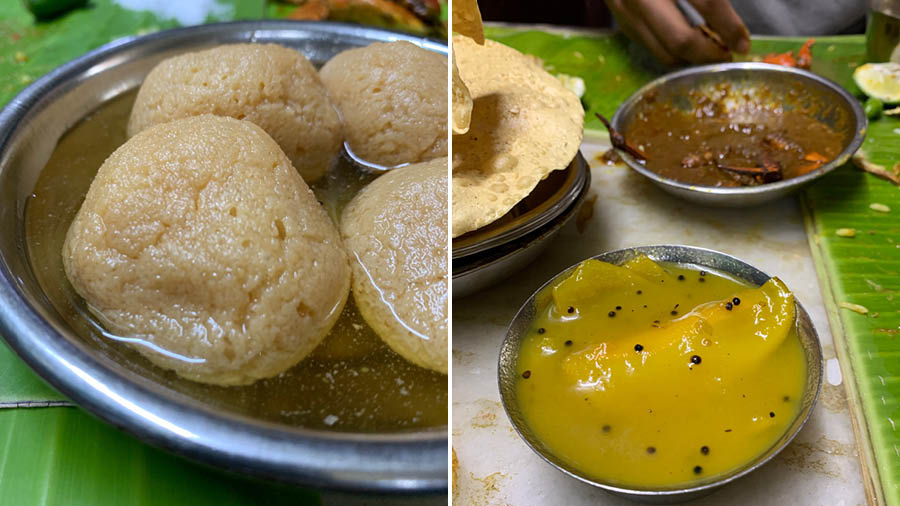
The gur’r roshgolla and aam’r tok
All in all, just like a great vintage, this was a great day and meal at Tarun Niketan. One that makes me proud of the region’s cuisine and institutions, but more than anything, one meal that you should seek out if you’re looking for that quintessential Bangla ranna experience.
P.S. Pinch to the pocket was Rs 2,000, tips included. The higher bill was down to the fact that we greedily ordered double portions of a lot of the preps.
A copywriter by training, a Delhi-ite at heart and a probashi Bengali by blood, Auroni Mookerjee used to make ads for a living. A few years ago, he gave up his copywriter’s job to cook and feed people full-time, and moved to the deliciously joyous city of Kolkata. Now, he is executive chef and head of the kitchen family at the Sienna Store & Cafe.


